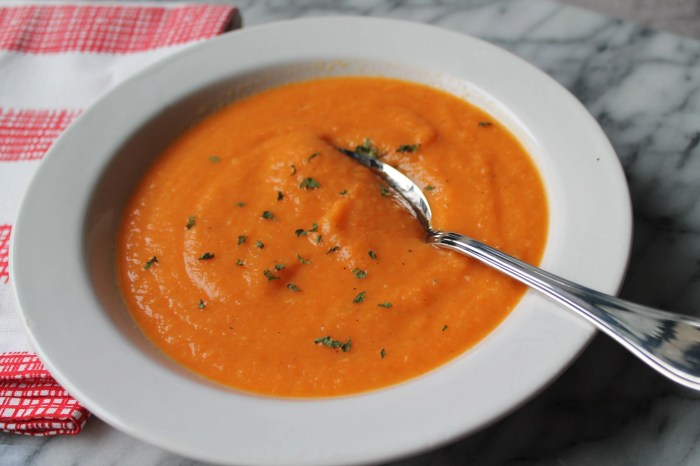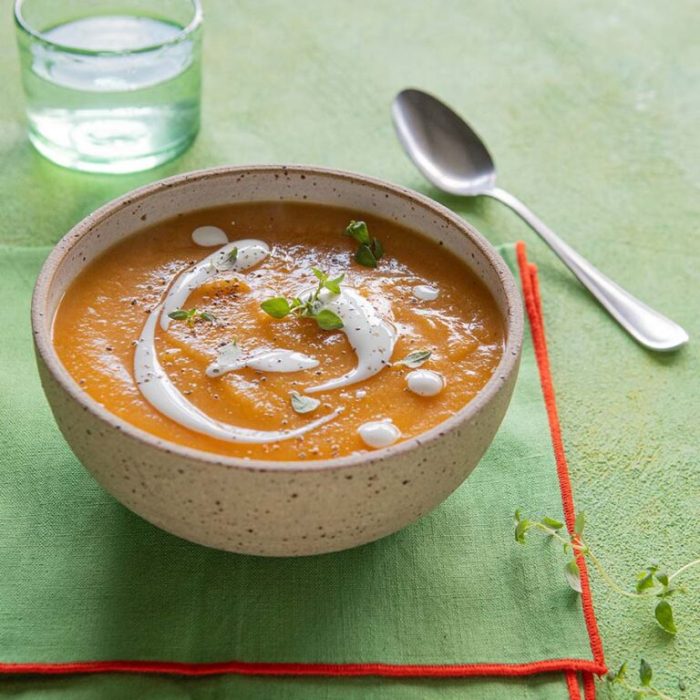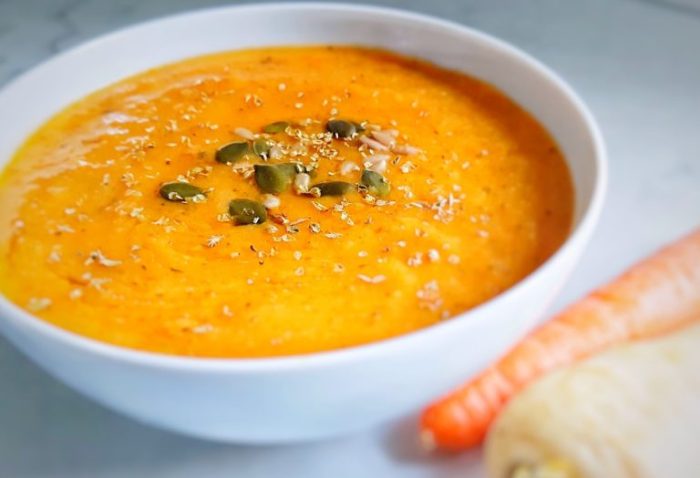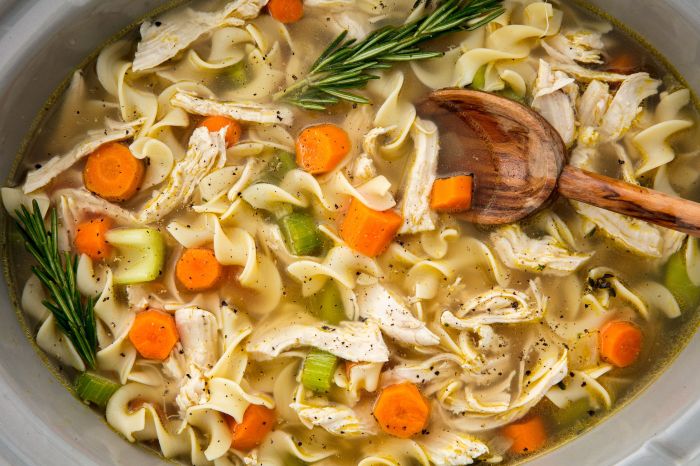Recipe Variations: Carrot And Parsnip Soup Recipe
Carrot and parsnip soup recipe – Carrot and parsnip soup is incredibly versatile, lending itself to a wide range of flavor profiles and cooking methods. The basic recipe can be easily adapted to suit different dietary needs and preferences, offering a delicious and healthy meal every time. Below are a few variations to inspire your culinary creativity.
Three Distinct Carrot and Parsnip Soup Recipes
The following table Artikels three distinct variations: a classic version, a vegan version, and a spiced version incorporating ginger and turmeric. These recipes offer a range of flavors and textures, demonstrating the adaptability of this simple yet satisfying soup.
| Ingredient | Quantity | Unit | Notes |
|---|---|---|---|
| Carrots | 500g | grams | Peeled and chopped |
| Parsnips | 250g | grams | Peeled and chopped |
| Vegetable Broth | 1L | liter | |
| Onion | 1 | medium | Finely chopped |
| Butter | 2 tbsp | tablespoons | |
| Salt and Pepper | To taste |
| Ingredient | Quantity | Unit | Notes |
|---|---|---|---|
| Carrots | 500g | grams | Peeled and chopped |
| Parsnips | 250g | grams | Peeled and chopped |
| Vegetable Broth | 1L | liter | |
| Onion | 1 | medium | Finely chopped |
| Olive Oil | 2 tbsp | tablespoons | |
| Salt and Pepper | To taste |
| Ingredient | Quantity | Unit | Notes |
|---|---|---|---|
| Carrots | 500g | grams | Peeled and chopped |
| Parsnips | 250g | grams | Peeled and chopped |
| Vegetable Broth | 1L | liter | |
| Onion | 1 | medium | Finely chopped |
| Ginger | 1 tbsp | tablespoon | Grated |
| Turmeric | 1 tsp | teaspoon | |
| Coconut Milk | 100ml | milliliters | Adds creaminess |
| Olive Oil | 2 tbsp | tablespoons | |
| Salt and Pepper | To taste |
Roasted Vegetable Variation
Roasting the carrots and parsnips before adding them to the soup significantly enhances the flavor. The roasting process caramelizes the vegetables, creating a deeper, sweeter, and more complex taste. The vegetables also develop a softer texture, contributing to a richer, more luxurious soup. To roast, toss the chopped vegetables with olive oil, salt, and pepper, then spread them in a single layer on a baking sheet.
Roast at 400°F (200°C) for 20-25 minutes, or until tender and slightly caramelized. Then, proceed with your chosen soup recipe, adding the roasted vegetables to the pot along with the other ingredients.
Pressure Cooker Adaptation
Using a pressure cooker significantly reduces the cooking time for carrot and parsnip soup. Simply add all ingredients (excluding any final seasonings) to the pressure cooker. Cook on high pressure for 10-12 minutes, followed by a natural pressure release for 10 minutes. Then, carefully release any remaining pressure and blend the soup to your desired consistency. Season to taste before serving.
The pressure cooking method results in a smoother, creamier texture compared to stovetop methods.
Ingredient Selection and Preparation

Source: thekittchen.com
Creating a truly exceptional carrot and parsnip soup hinges on selecting the right ingredients and preparing them meticulously. The quality of your vegetables directly impacts the final flavor and texture of the soup, so careful attention to this stage is crucial.The best carrots for soup are those that are firm, vibrant in color, and free from blemishes. Look for carrots that are relatively straight and uniform in size for easier chopping.
While many varieties will work well, those with a sweeter flavor profile, such as Nantes or Imperator carrots, will contribute a more pleasant sweetness to the soup. Similarly, when choosing parsnips, select those that are firm, have smooth skin, and are free from soft spots or discoloration. Parsnips with a deep, creamy color generally indicate better flavor.
Avoid parsnips that are overly woody or have a noticeably strong, earthy aroma, as this can overpower the other flavors in the soup.
Cleaning and Preparing Vegetables
Thorough cleaning is paramount before any cooking begins. Begin by scrubbing the carrots and parsnips under cold running water, using a vegetable brush to remove any ingrained dirt or debris. This is particularly important for parsnips, as their rougher skin can harbor more soil. Once clean, trim off the ends of both the carrots and parsnips. For carrots, you can also peel them using a vegetable peeler, although many recipes call for leaving the skin on for added nutrients and a slightly earthier flavor.
If peeling, be sure to remove any particularly tough or fibrous areas. Parsnips should generally be peeled to remove their tough outer skin. After peeling, carefully examine the vegetables for any remaining imperfections and trim them away.
Chopping Methods and Their Effects
The method of chopping your carrots and parsnips significantly influences the soup’s final texture. Different cuts provide varying results.
- Diced: Dicing carrots and parsnips into small, roughly uniform cubes (about ½ inch) results in a smooth and creamy soup. The even cooking ensures a consistent texture throughout. This is a classic and versatile approach for most carrot and parsnip soup recipes.
- Julienned: Julienned carrots and parsnips, cut into long, thin strips, offer a slightly different textural experience. While still yielding a relatively smooth soup, the julienned pieces retain a bit more structure, providing a subtle textural contrast. This method might be preferred if you desire a soup with slightly more bite.
- Roughly Chopped: A coarser chop, leaving larger pieces, will create a chunkier soup with a more rustic feel. This method is suitable for those who prefer a more substantial texture in their soup, allowing for a pleasing contrast between the softer cooked vegetables and the firmer, less cooked pieces. This can be a great option for adding more visual interest.
Broth and Flavor Enhancement

Source: boredoflunch.com
The choice of broth and the addition of herbs, spices, and aromatics significantly impact the final flavor profile of carrot and parsnip soup. A subtle shift in broth can alter the overall taste, while strategic additions of flavor enhancers can create a complex and delicious culinary experience. Careful consideration of these elements is key to achieving a truly exceptional soup.
Selecting the right broth forms the foundation of your soup’s flavor. Different broths contribute unique characteristics, influencing the overall taste and depth of the final product.
Alternative Broths and Their Impact on Taste, Carrot and parsnip soup recipe
- Vegetable Broth: This provides a clean, subtly sweet base that complements the natural sweetness of carrots and parsnips. It’s a versatile option suitable for vegetarians and vegans, allowing the inherent flavors of the vegetables to shine.
- Chicken Broth: Adding chicken broth introduces a savory, umami richness that enhances the sweetness of the carrots and parsnips. The depth of flavor from the chicken broth creates a more substantial and comforting soup.
- Beef Broth: A beef broth will lend a deeper, earthier flavor to the soup, contrasting nicely with the sweetness of the vegetables. This choice is ideal for those seeking a heartier, more robust taste profile.
Beyond the broth itself, the strategic use of herbs, spices, and aromatics is crucial for creating layers of flavor and complexity. These additions can transform a simple soup into a culinary masterpiece.
Flavor Enhancement with Herbs, Spices, and Aromatics
Aromatic vegetables and herbs provide depth and complexity to the carrot and parsnip soup. Consider these options and their respective impacts.
- Onion and Garlic: These foundational aromatics form the base of many savory dishes. Sautéing them before adding the other ingredients builds a rich foundation of flavor.
- Thyme: This earthy herb adds a subtle, slightly lemony note that pairs beautifully with carrots and parsnips. A few sprigs during simmering infuse the soup with a delightful fragrance.
- Bay Leaf: A single bay leaf adds a subtle warmth and complexity, contributing to the overall depth of flavor. Remember to remove it before serving.
- Ginger: Freshly grated ginger introduces a spicy warmth that cuts through the sweetness of the carrots and parsnips. Use sparingly to avoid overpowering the other flavors.
- Nutmeg: A pinch of freshly grated nutmeg adds a warm, slightly sweet spice note that complements the earthiness of the parsnips. A little goes a long way.
Cream and Milk Variations for Richness and Texture
The addition of cream or milk significantly influences the soup’s richness and texture. Different dairy options yield distinct results.
- Heavy Cream: This creates the richest, most decadent soup, adding a luxurious mouthfeel and intense creaminess. It’s ideal for a special occasion or when you want an indulgent treat.
- Half-and-Half: This offers a balance between richness and lightness, providing creaminess without being overly heavy. It’s a good all-around choice for a satisfying yet not overly rich soup.
- Whole Milk: This adds a milder creaminess, resulting in a lighter soup. It’s a good option if you prefer a less rich texture or are watching your fat intake.
- Coconut Milk: For a unique twist, coconut milk provides a creamy texture with a subtle tropical sweetness. This adds an interesting dimension to the traditional carrot and parsnip soup, offering a slightly sweeter and richer flavor profile.
Serving Suggestions and Garnish

Source: nicolamonson.com
This section explores creative ways to serve your carrot and parsnip soup, elevating it from a simple meal to a truly memorable culinary experience. We’ll examine several serving suggestions and garnish options to enhance both the visual appeal and the overall flavor profile of this delightful soup. The right presentation can significantly impact the enjoyment of any dish.Serving your carrot and parsnip soup in a variety of ways can make it more versatile and appealing to a wider range of palates.
Consider these options to transform a simple soup into a sophisticated and satisfying meal.
Creative Serving Suggestions
The creamy texture of carrot and parsnip soup lends itself well to various serving styles. Here are three unique approaches to elevate your presentation and dining experience.
- Soup Shooters: Serve the soup in small, elegant shot glasses for a sophisticated appetizer. This presentation is perfect for parties or special occasions, allowing guests to easily sample the soup’s rich flavor. The smaller portion size also encourages trying other appetizers.
- Layered Soup with Croutons: Create a visually appealing layered soup by alternating layers of carrot and parsnip soup with toasted croutons in a tall glass or bowl. This presentation adds textural contrast and enhances the overall aesthetic appeal. The croutons provide a satisfying crunch that complements the smooth soup.
- Soup as a Base for Roasted Vegetables: Use the soup as a flavorful base for roasted root vegetables such as carrots, parsnips, and sweet potatoes. This transforms the soup from a standalone dish into a hearty and visually stunning main course. The roasted vegetables add a depth of flavor and contrasting textures.
Garnish Options to Enhance the Soup
Garnishes are crucial for enhancing both the visual appeal and the flavor complexity of your carrot and parsnip soup. These additions provide a delightful contrast in texture and taste.
- Toasted Pumpkin Seeds: These offer a satisfying crunch and a nutty, slightly sweet flavor that complements the sweetness of the carrots and parsnips. The slight bitterness of the seeds provides a welcome counterpoint to the overall sweetness of the soup. Their vibrant green color also adds visual interest.
- Fresh Chives: The delicate, oniony flavor of fresh chives adds a subtle savory note that cuts through the richness of the soup. Their vibrant green color provides a beautiful contrast against the soup’s orange hue. The soft texture of the chives contrasts nicely with the creamy soup.
- A Swirl of Crème Fraîche: A dollop of crème fraîche adds a tangy and creamy element to the soup, enhancing its richness and providing a smooth, cool contrast to the warm soup. The subtle tanginess of the crème fraîche balances the sweetness of the carrots and parsnips, adding a layer of complexity to the flavor profile.
Accompaniments for Carrot and Parsnip Soup
Several accompaniments can elevate the enjoyment of your carrot and parsnip soup. These options offer varied flavor profiles and textures that complement the soup’s creamy nature.
A simple carrot and parsnip soup recipe often features warming spices and a touch of sweetness. For a richer, creamier alternative, consider the delightful flavors found in a butternut squash soup; you might find inspiration in this excellent butternut squash soup recipe with cream cheese. Returning to our carrot and parsnip soup, remember to adjust seasoning to your preference for a truly satisfying bowl.
- Crusty Bread: The perfect vehicle for sopping up every last drop of the delicious soup. A rustic sourdough or a hearty multigrain bread provides a satisfying contrast in texture.
- Grilled Cheese Sandwich: The combination of creamy soup and a melty, cheesy sandwich is a classic comfort food pairing. The richness of the cheese complements the sweetness of the soup.
- Arugula Salad with Lemon Vinaigrette: A light and peppery arugula salad provides a refreshing contrast to the richness of the soup. The tangy lemon vinaigrette cuts through the sweetness.
- Roasted Chicken or Turkey: The savory flavors of roasted poultry complement the sweetness of the soup. The combination creates a balanced and satisfying meal.
- Sautéed Mushrooms: Earthy and savory sautéed mushrooms add a depth of flavor and textural contrast to the smooth soup. The umami notes of the mushrooms enhance the overall taste profile.
Nutritional Information and Health Benefits
Carrot and parsnip soup offers a nutritious and delicious way to incorporate essential vitamins and minerals into your diet. This simple soup is surprisingly packed with nutrients, contributing to overall health and well-being when consumed as part of a balanced meal plan. The following sections detail the nutritional profile and highlight the key health benefits associated with this comforting dish.
Nutritional Breakdown per Serving (Approximate)
A typical serving (approximately 1.5 cups) of carrot and parsnip soup, prepared without added cream or excessive oil, provides a range of essential nutrients. The exact values can vary depending on the specific ingredients used and the recipe followed. However, the following table presents a reasonable estimate:
| Nutrient | Quantity | Unit | % Daily Value |
|---|---|---|---|
| Calories | 150-200 | kcal | 7-10% |
| Vitamin A | 1500-2500 | µg | 17-28% |
| Vitamin C | 10-20 | mg | 11-22% |
| Potassium | 400-600 | mg | 9-14% |
| Fiber | 4-6 | g | 16-24% |
| Vitamin K | 10-20 | µg | 8-17% |
| Folate | 20-40 | µg | 5-10% |
*Note: Daily values are based on a 2000 calorie diet. Individual needs may vary.*
Health Benefits of Carrots and Parsnips
Carrots are renowned for their high beta-carotene content, which the body converts into Vitamin A. Vitamin A is crucial for vision, immune function, and cell growth. Parsnips, similarly, offer a good source of Vitamin C, an antioxidant that supports the immune system and collagen production. Both vegetables are also rich in fiber, promoting digestive health and contributing to feelings of fullness, aiding in weight management.
Furthermore, they provide essential minerals like potassium, important for maintaining healthy blood pressure.
Health Benefits of Regular Consumption
Regular consumption of carrot and parsnip soup, as part of a balanced diet, can contribute to several health benefits. The high fiber content aids in digestion and can help regulate blood sugar levels. The abundance of vitamins and minerals supports overall immune function and promotes healthy skin and vision. The soup’s low calorie density makes it a suitable choice for those seeking to maintain a healthy weight.
The potassium content can contribute to maintaining healthy blood pressure. However, it’s important to note that this soup should not be considered a sole source of nutrition, and a varied and balanced diet is always recommended.
Top FAQs
Can I freeze carrot and parsnip soup?
Yes, carrot and parsnip soup freezes well. Allow it to cool completely before storing in airtight containers for up to 3 months.
What if my soup is too thick?
Thin it out with a little more broth or water until you reach your desired consistency.
Can I use other root vegetables?
Absolutely! Celery root, turnips, or sweet potatoes can be added for extra flavor and nutrients.
How long will leftover soup last in the refrigerator?
Store leftover soup in an airtight container in the refrigerator for up to 3-4 days.


